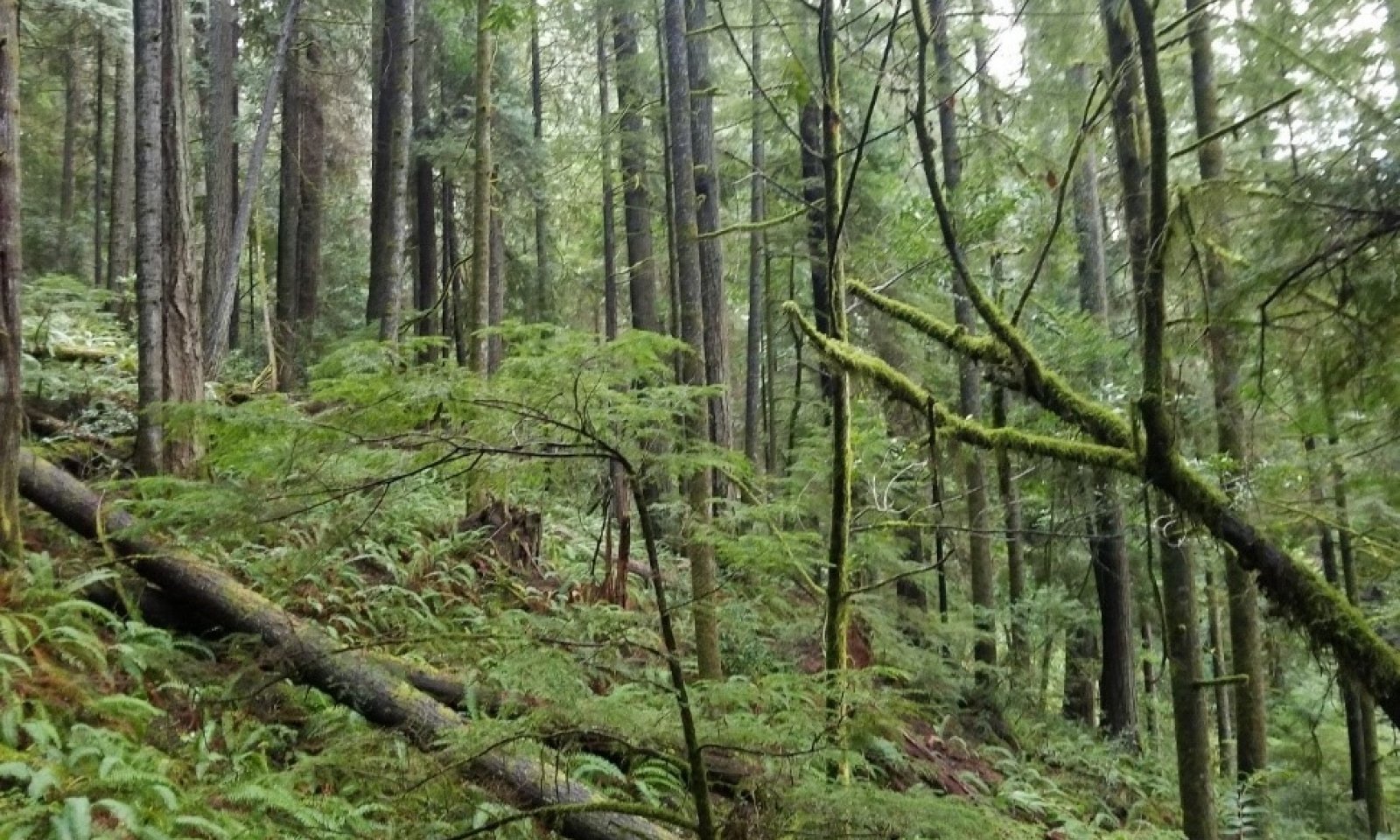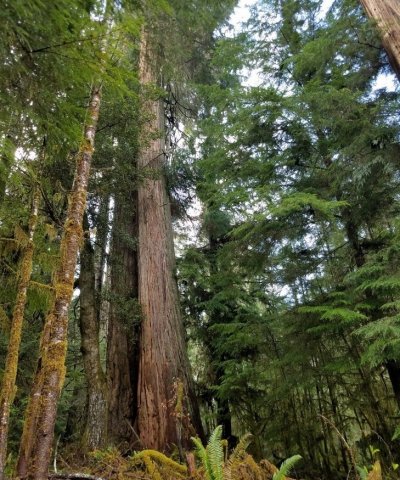Community 1.1
Port Orford Cedar, Western Hemlock, Salal, Pacific Rhododendron, Western Swordfern, and Oregon Oxalis
Port Orford cedar – western hemlock / salal –Pacific rhododendron / western swordfern – Oregon oxalis
Structure: mosaic of mature overstory and regenerating openings
Port Orford cedar and western hemlock are the most common overstory species in the Reference Community. Douglas-fir, grand fir, and tanoak are also likely present. Gaps in the mid-canopy and overstory allow sunlight to reach the ground and are where the majority of the understory plants establish. In addition, these gaps provide opportunities for deciduous tree species such as red alder and bigleaf maple (Acer macrophyllum) to regenerate throughout this reference community. Common understory shrub species include salal, Pacific rhododendron, red huckleberry (Vaccinium parvifolium), evergreen huckleberry, vine maple (Acer circinatum), Cascade oregongrape, western swordfern, and Oregon oxalis.
Dominant plant species
-
Port Orford cedar (Chamaecyparis lawsoniana), tree
-
western hemlock (Tsuga heterophylla), tree
-
Douglas-fir (Pseudotsuga menziesii), tree
-
grand fir (Abies grandis), tree
-
tanoak (Notholithocarpus densiflorus), tree
-
salal (Gaultheria shallon), shrub
-
Pacific rhododendron (Rhododendron macrophyllum), shrub
-
California huckleberry (Vaccinium ovatum), shrub
-
Cascade barberry (Mahonia nervosa), shrub
-
vine maple (Acer circinatum), shrub
-
western swordfern (Polystichum munitum), other herbaceous
-
redwood-sorrel (Oxalis oregana), other herbaceous
Community 1.2
Red Alder, Red Huckleberry, Salmonberry, and Western Swordfern
Red alder / red huckleberry - salmonberry / western swordfern
Structure: open forest with shrubby regeneration and snags
Community phase 1.2 is an early seral plant community that has been impacted by a stand-replacing disturbance such as a wildfire, large scale wind event, mass movement, or major insect pest or disease. Nearly all trees are absent, but some fire-resistant trees may survive in the overstory. Port Orford cedar is relatively fire tolerant, and large overstory trees may be present. Snags are prevalent and remain standing and decaying. Large woody debris may be present on the surface and serve as nurse sites. The understory is predominately early seral tree, shrub, and forb species such as red alder, red huckleberry, and salmonberry. Red alder has several competitive advantages and can establish quickly, relative to conifers. Red alder can sprout and establish in full sunlight and fixes nitrogen providing an early competitive advantage (Villarin, 2009). In addition, the seeds of deciduous species are light and can be transported long distances by wind and water, allowing for rapid recolonization. Red alder seedlings and saplings will typically establish 3 to10 years following disturbance, depending on severity.
Community 1.3
Douglas-fir, Port Orford Cedar, Red Huckleberry, Salal, and Western Swordfern
Douglas-fir – Port Orford cedar / red huckleberry - salal / western swordfern
Structure: dense single story
Community phase 1.3 is an early seral forest in regeneration, possibly with scattered remnant mature trees. Species composition depends on the natural seed sources present and the intensity of disturbance. When resulting from a moderate to severe fire event, it is probable that shrubs will out-compete tree seedlings. Red alder, red huckleberry, evergreen huckleberry, western swordfern, and salmonberry may be abundant in the understory depending on sunlight availability (Bailey, 1968).
Red alder will begin to die between 40 to 70 years following disturbance and allow more light to penetrate the newly nitrogen rich soil (Naiman, 2009). As a result, conifer regeneration becomes more prevalent in this community phase. Seed sources for tree species would be from the surrounding, undisturbed forest. The combination of new seedling growth and the survivors of the previous disturbance would result in a mixed stand which could include Douglas-fir and Port Orford cedar.
Community 1.4
Port Orford Cedar, Douglas-fir, Salal, Cascade Oregongrape, and Western Swordfern
Port Orford cedar – Douglas-fir / salal – Cascade Oregongrape / western swordfern
Structure: dense single story with diminished understory
Community phase 1.4 is a forest in the competitive exclusion stage, possibly with scattered remnant mature trees. There is increasing competition among individual trees for available water and nutrients. Douglas-fir and Port Orford cedar will dominate the overstory canopy, however red alder may be present in pockets of canopy openings. In addition, western hemlock is shade tolerant and will begin to establish in the shade of mature Douglas-fir and Port Orford cedar trees. Canopy closure is almost 100 percent leading to diminished shrub and forb layers. Some understory species better adapted to at least partial shade will begin to increase. Over time, the forest will begin to self-thin due to the elevated competition.
Pathway 1.1A
Community 1.1 to 1.2
This pathway represents a major stand-replacing disturbance such as a high-intensity fire, large scale wind event, major insect pest infestation, timber management, or large mass movement event leading to the stand initiation phase of forest development.
Pathway 1.2A
Community 1.2 to 1.3
This pathway represents growth over time with no further significant disturbance.
Pathway 1.3A
Community 1.3 to 1.2
This pathway represents a major stand-replacing disturbance such as a high-intensity fire, large scale wind event, major insect pest or disease infestation, timber management, or large mass movement leading to the stand initiation phase of forest development.
Pathway 1.3B
Community 1.3 to 1.4
This pathway represents growth over time with no further significant disturbance.
Pathway 1.4B
Community 1.4 to 1.1
Port Orford Cedar, Douglas-fir, Salal, Cascade Oregongrape, and Western Swordfern
Port Orford Cedar, Western Hemlock, Salal, Pacific Rhododendron, Western Swordfern, and Oregon Oxalis
This pathway represents growth over time with no further major disturbance.
Pathway 1.4A
Community 1.4 to 1.2
This pathway represents a major stand-replacing disturbance such as a high-intensity fire, large scale wind event, major insect pest or disease infestation, timber management, or large mass movement leading to the stand initiation phase of forest development.
Community 2.1
Red Alder and Himalayan Blackberry
Red alder/Himalayan blackberry
Structure: Open forest with regeneration and large woody debris
Community Phase 2.1 represents a recently disturbed forest that is naturally regenerating. Large woody debris are often prolific following large-scale disturbances which inhibits vegetation to establish under natural conditions. Areas that are not replanted immediately (1 to 3 years) following a timber harvest or large-scale disturbance may become vulnerable to invasive species infestation.
Typically, commercially managed forests will be replanted following disturbance and species preference depends on site conditions and long-term economic market decisions. Overall, species biodiversity in forests managed for short rotation timber is diminished.
Natural reforestation depends on available seed sources following disturbance. Early seral species such as red alder tend to regenerate quickly with abundant sunlight. Plant community composition is typically homogenous and even-aged. Following disturbance, these sites are often dominated by Himalayan blackberry (Rubus armeniacus) which tend to outcompete native species establishment. Invasive species management is most critical during this phase.
Community 2.2
Douglas-fir, Red Alder, Salmonberry, and Himalayan Blackberry
Douglas-fir-red alder/salmonberry-Himalayan blackberry
Structure: Single story
Community phase 2.2 represents an even-aged, regenerating forest. Douglas-fir can regenerate quickly on nurse logs or in recently disturbed soils. Shade-intolerant red alder remains a large component in the overstory until it reaches maturity (Fonda, 1974).
The vegetation in areas that have been replanted commonly is dense and even aged, and the understory species are sparse in areas that have a high percentage of canopy cover. Salmonberry is a common understory species, but invasive species increase in prominence. Himalayan blackberry can greatly impact the shrubby understory and outcompete native species. Management techniques such as pre-commercial thinning and mitigation of invasive species will accelerate the maturation and improve the health of the forest.
Community 2.3
Western Hemlock, Port Orford Cedar, Salal, and Himalayan Blackberry
Western hemlock-Port Orford cedar/salal-Himalayan blackberry
Structure: Dense single story with diminished understory
Community phase 2.3 represents a maturing forest that has increased plant diversity. Western hemlock and Port Orford cedar will begin to regenerate under dense, shrubby canopies. It will begin to establish in the overstory canopy along with Douglas-fir. Invasive species will inhibit the overall health and structure of the forest, creating an ecosystem which is susceptible to devastation from insects and disease. The dense, shrubby understory is susceptible to wildfires.
Commercial logging operations commonly take place during this phase as trees reach economical maturity in size and volume. It is presumed that without timber management during this phase, an old-growth western hemlock and Port Orford cedar stand will develop.
Pathway 2.1A
Community 2.1 to 2.2
This pathway represents growth over time with no further major disturbance or active forest management.
Pathway 2.2B
Community 2.2 to 2.1
This pathway represents a major stand-replacing disturbance such as a high-intensity fire, a large-scale wind event, a major insect or disease infestation, large mass movement, or timber harvest activities that lead to the stand initiation phase of forest development.
Pathway 2.2A
Community 2.2 to 2.3
This pathway represents growth over time with no further major disturbance or active forest management.
Pathway 2.3A
Community 2.3 to 2.1
This pathway represents a major stand-replacing disturbance such as a high-intensity fire, a large-scale wind event, a major insect or disease infestation, large mass movement, or timber harvest activities that lead to the stand initiation phase of forest development.
Transition T1A
State 1 to 2
This pathway represents an area of major disturbance that removes most of the overstory. Large-scale disturbances such as this, have the potential to increase the vulnerability of invasive species infestation when the seed source is either nearby or introduced to the site. This type of disturbance will impact the ecological site and the natural feedbacks that maintained the reference state.
Transition T2A
State 2 to 1
This pathway represents intensive management to restore the historic plant community.




